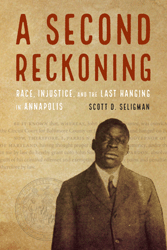|
 It
took less than two days
after the body of Lottie Mae
Brandon, a pregnant white
newlywed, was found in her
Annapolis flat in 1917 for
the editor of the local
newspaper – based on no
evidence at all – to
conclude that her murder
must have been the work of a
Black man. It took only 22
minutes for an all-white
jury to convict John
Snowden, an African-American
iceman, for the crime and
sentence him to death, based
entirely on circumstantial
evidence. But it took more
than eight decades after his
death for him
to be pardoned for the
murder that many believe to
this day he did not commit. It
took less than two days
after the body of Lottie Mae
Brandon, a pregnant white
newlywed, was found in her
Annapolis flat in 1917 for
the editor of the local
newspaper – based on no
evidence at all – to
conclude that her murder
must have been the work of a
Black man. It took only 22
minutes for an all-white
jury to convict John
Snowden, an African-American
iceman, for the crime and
sentence him to death, based
entirely on circumstantial
evidence. But it took more
than eight decades after his
death for him
to be pardoned for the
murder that many believe to
this day he did not commit.
Snowden’s was the
last hanging Anne Arundel
County, Maryland would ever
see. But it was the one
Annapolis would remember for
a century.
Set in
Jim Crow Maryland, the book
recounts the story of a case
many Black and white
Annapolitans saw as a “legal
lynching.” It takes the
reader through the discovery
of the murder, the police
investigation that followed,
the arrest of Snowden, his
brutal interrogation, his
trial and his unsuccessful
appeal, the stubborn refusal
of the then-governor to
commute his sentence and his
death on the scaffold.
 It then picks the story
up in the 1990s, chronicling
the efforts of an activist
Annapolis alderman who,
working with Snowden’s
family members and others,
pressed for a posthumous
pardon for Snowden against
the backdrop of a national
debate over the future of
the death penalty and a
growing body of evidence of
the corrupting role race
plays in its imposition. The
Snowden case was a way
station on the road to total
abolition of the death
penalty in the state. It then picks the story
up in the 1990s, chronicling
the efforts of an activist
Annapolis alderman who,
working with Snowden’s
family members and others,
pressed for a posthumous
pardon for Snowden against
the backdrop of a national
debate over the future of
the death penalty and a
growing body of evidence of
the corrupting role race
plays in its imposition. The
Snowden case was a way
station on the road to total
abolition of the death
penalty in the state.
But it was more than
that. It was also a stand-in
for countless other cases in
which justice may not have
been done. The book brings
posthumous pardons into the
national conversation on
amends for past racial
injustices. It argues that
the repeal of blatantly
racist laws and changes in
federal, state and local
government policies are
insufficient and must be
augmented with a reckoning
with our judicial past,
especially those instances
in which prejudice may have
tainted procedures or
perverted verdicts. It
illustrates the profound
effects of such acts of
clemency on people very much
alive today, and issues a
siren call for a
re-examination of such cases
on the national level,
especially by the U. S.
Department of Justice, which
to this day officially
refuses even to consider
them.
|